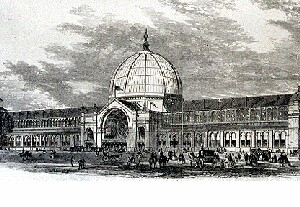|
The London World Exposition 1862
|
Year: | 1862 | | City: | London | | Country: | Great Britain | | Duration: | 1st May - 1st November 1862
|
|
1
| 
Copyright: Illustrierter Katalog, Leipzig 1864, Bd. 2, S. 181 |
|
Facts and Figures
Official title: The London International Exhibition on Industry and Art of 1862
Planning began: 1858
Construction began: 9th March 1861
Opened: 1st May 1862
Duration: 1st May – 1st November 1862 (184 days)
Location: South Kensington, in the gardens of the Royal Horticultural Society
Symbol: Exhibition Palace, with the two largest domes in the world
Innovations: Babbage’s analytical engine, the use of caoutchouc for the production of rubber, the Bessemer steel production process
Organisation: Royal Society of Arts, Manufactures and Trade; from 1861, a Royal Commission
President: Earl Granville
Architect: Captain Francis Fowke
Surface area of the Exhibition: 12.5 hectares
Exhibitors: approx. 29,000, of which 9,000 from Great Britain and 2,600 from the British colonies
Organisation of exhibits: 4 sections, 40 classes
Foreign participating countries: 36 countries
Visitors: 6.1 million
Entrance price: depending on the day, between a shilling and a pound
Cost: £458,842
Takings: £459,632
Profit: £790
Jury: composed of 296 British and 271 foreign members spread over the 36 industrial and agricultural classes
Awards: 7,000 medals and 5,300 honourable citations
|



